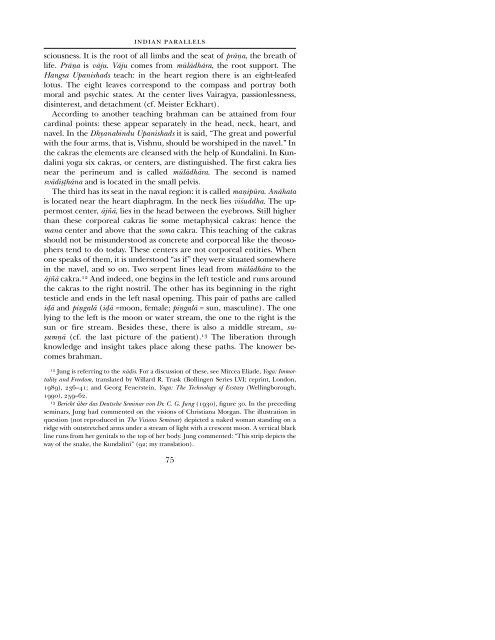CG JUNG - Countryside Anarchist
CG JUNG - Countryside Anarchist
CG JUNG - Countryside Anarchist
You also want an ePaper? Increase the reach of your titles
YUMPU automatically turns print PDFs into web optimized ePapers that Google loves.
INDIAN PARALLELS<br />
sciousness. It is the root of all limbs and the seat of prvõa, the breath of<br />
life. Prvõa is vvju. Vvju comes from mÖlvdhvra, the root support. The<br />
Hangsa Upanishads teach: in the heart region there is an eight-leafed<br />
lotus. The eight leaves correspond to the compass and portray both<br />
moral and psychic states. At the center lives Vairagya, passionlessness,<br />
disinterest, and detachment (cf. Meister Eckhart).<br />
According to another teaching brahman can be attained from four<br />
cardinal points: these appear separately in the head, neck, heart, and<br />
navel. In the Dhyanabindu Upanishads it is said, “The great and powerful<br />
with the four arms, that is, Vishnu, should be worshiped in the navel.” In<br />
the cakras the elements are cleansed with the help of Kundalini. In Kundalini<br />
yoga six cakras, or centers, are distinguished. The first cakra lies<br />
near the perineum and is called mÖlvdhvra. The second is named<br />
svvdiü°hvna and is located in the small pelvis.<br />
The third has its seat in the naval region: it is called maõipÖra. Anvhata<br />
is located near the heart diaphragm. In the neck lies viçuddha. The uppermost<br />
center, vjñv, lies in the head between the eyebrows. Still higher<br />
than these corporeal cakras lie some metaphysical cakras: hence the<br />
mana center and above that the soma cakra. This teaching of the cakras<br />
should not be misunderstood as concrete and corporeal like the theosophers<br />
tend to do today. These centers are not corporeal entities. When<br />
one speaks of them, it is understood “as if” they were situated somewhere<br />
in the navel, and so on. Two serpent lines lead from mÖlvdhvra to the<br />
vjñv cakra. 12 And indeed, one begins in the left testicle and runs around<br />
the cakras to the right nostril. The other has its beginning in the right<br />
testicle and ends in the left nasal opening. This pair of paths are called<br />
iìv and piõgalv (iìv =moon, female; piõgalv = sun, masculine). The one<br />
lying to the left is the moon or water stream, the one to the right is the<br />
sun or fire stream. Besides these, there is also a middle stream, suüumõv<br />
(cf. the last picture of the patient). 13 The liberation through<br />
knowledge and insight takes place along these paths. The knower becomes<br />
brahman.<br />
12 Jung is referring to the nvìzs. For a discussion of these, see Mircea Eliade, Yoga: Immortality<br />
and Freedom, translated by Willard R. Trask (Bollingen Series LVI; reprint, London,<br />
1989), 236–41; and Georg Feuerstein, Yoga: The Technology of Ecstasy (Wellingborough,<br />
1990), 259–62.<br />
13 Bericht über das Deutsche Seminar von Dr. C. G. Jung (1930), figure 30. In the preceding<br />
seminars, Jung had commented on the visions of Christiana Morgan. The illustration in<br />
question (not reproduced in The Visions Seminar) depicted a naked woman standing on a<br />
ridge with outstretched arms under a stream of light with a crescent moon. A vertical black<br />
line runs from her genitals to the top of her body. Jung commented: “This strip depicts the<br />
way of the snake, the Kundalini” (92; mytranslation).<br />
75


